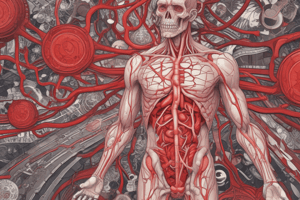Podcast
Questions and Answers
Metabolic heat is a type of external heat.
Metabolic heat is a type of external heat.
False (B)
Evaporation is a mechanism of heat gain.
Evaporation is a mechanism of heat gain.
False (B)
The human body's optimal temperature is around 40°C.
The human body's optimal temperature is around 40°C.
False (B)
The posterior hypothalamus detects changes in blood temperature.
The posterior hypothalamus detects changes in blood temperature.
Vasodilation is a mechanism of heat gain.
Vasodilation is a mechanism of heat gain.
Shivering is a mechanism to reduce heat loss.
Shivering is a mechanism to reduce heat loss.
Fever is a normal body temperature response.
Fever is a normal body temperature response.
Hypothermia is a body temperature above 40°C.
Hypothermia is a body temperature above 40°C.
Diet-induced thermogenesis is a type of heat loss mechanism.
Diet-induced thermogenesis is a type of heat loss mechanism.
Conduction is a type of heat gain mechanism.
Conduction is a type of heat gain mechanism.
Sweating is an example of a thermoregulatory reflex that helps to conserve heat.
Sweating is an example of a thermoregulatory reflex that helps to conserve heat.
Vasoconstriction is a thermoregulatory response that helps to increase blood flow to the skin.
Vasoconstriction is a thermoregulatory response that helps to increase blood flow to the skin.
Thermoreceptors in the hypothalamus detect changes in environmental temperature.
Thermoreceptors in the hypothalamus detect changes in environmental temperature.
A negative feedback loop is a type of thermoregulatory response that amplifies changes in body temperature.
A negative feedback loop is a type of thermoregulatory response that amplifies changes in body temperature.
Shivering is a type of thermoregulatory reflex that helps to reduce heat loss.
Shivering is a type of thermoregulatory reflex that helps to reduce heat loss.
Radiation is a type of heat loss mechanism that involves the movement of warm air away from the body.
Radiation is a type of heat loss mechanism that involves the movement of warm air away from the body.
The hypothalamus is the primary thermoregulatory center in the brain.
The hypothalamus is the primary thermoregulatory center in the brain.
Convection is a type of heat loss mechanism that involves the evaporation of sweat from the skin.
Convection is a type of heat loss mechanism that involves the evaporation of sweat from the skin.
Flashcards are hidden until you start studying
Study Notes
Temperature Regulation
Importance of Temperature Regulation
- Maintaining a constant body temperature (around 37°C) is crucial for proper bodily functions
- Temperature affects enzyme activity, metabolism, and nerve function
Thermoregulation Mechanisms
Heat Gain
- Metabolic heat: generated through cellular respiration and ATP production
- External heat: gained from the environment through radiation, conduction, and convection
Heat Loss
- Radiation: heat lost through electromagnetic waves
- Conduction: heat lost through direct contact with cooler objects
- Convection: heat lost through air or water movement
- Evaporation: heat lost through sweat evaporation
Thermoregulation Centers
- Hypothalamus: primary thermoregulation center in the brain
- Anterior hypothalamus: detects changes in blood temperature
- Posterior hypothalamus: responds to changes in skin temperature
Thermoregulation Pathways
- Heat gain pathway:
- Heat stimulates thermoreceptors in the skin
- Signals sent to the hypothalamus
- Hypothalamus activates sweat glands and increases blood flow to the skin
- Heat loss pathway:
- Cold stimulates thermoreceptors in the skin
- Signals sent to the hypothalamus
- Hypothalamus activates vasoconstriction and increases metabolic rate
Effector Mechanisms
- Sweat glands: produce sweat to increase evaporation and heat loss
- Vasodilation: increases blood flow to the skin to increase heat loss
- Vasoconstriction: decreases blood flow to the skin to reduce heat loss
- Shivering: increases metabolic rate to generate heat
- Piloerection: increases insulation to reduce heat loss
Clinical Relevance
- Hypothermia: body temperature below 35°C
- Hyperthermia: body temperature above 40°C
- Fever: elevated body temperature in response to infection or inflammation
Temperature Regulation
Importance of Temperature Regulation
- Maintaining a constant body temperature of around 37°C is vital for proper bodily functions
- Temperature affects enzyme activity, metabolism, and nerve function
Thermoregulation Mechanisms
Heat Gain
- Metabolic heat is generated through cellular respiration and ATP production
- External heat is gained from the environment through radiation, conduction, and convection
Heat Loss
- Radiation is the process of heat lost through electromagnetic waves
- Conduction is the process of heat lost through direct contact with cooler objects
- Convection is the process of heat lost through air or water movement
- Evaporation is the process of heat lost through sweat evaporation
Thermoregulation Centers
- The hypothalamus is the primary thermoregulation center in the brain
- The anterior hypothalamus detects changes in blood temperature
- The posterior hypothalamus responds to changes in skin temperature
Thermoregulation Pathways
Heat Gain Pathway
- Heat stimulates thermoreceptors in the skin
- Signals are sent to the hypothalamus
- The hypothalamus activates sweat glands and increases blood flow to the skin
Heat Loss Pathway
- Cold stimulates thermoreceptors in the skin
- Signals are sent to the hypothalamus
- The hypothalamus activates vasoconstriction and increases metabolic rate
Effector Mechanisms
- Sweat glands produce sweat to increase evaporation and heat loss
- Vasodilation increases blood flow to the skin to increase heat loss
- Vasoconstriction decreases blood flow to the skin to reduce heat loss
- Shivering increases metabolic rate to generate heat
- Piloerection increases insulation to reduce heat loss
Clinical Relevance
- Hypothermia is a body temperature below 35°C
- Hyperthermia is a body temperature above 40°C
- Fever is an elevated body temperature in response to infection or inflammation
Thermoregulation Mechanisms
Heat Gain Mechanisms
- Metabolic heat production is the heat generated through cellular metabolic processes, such as cellular respiration and ATP production, which accounts for 60-70% of the body's total heat production.
- Diet-induced thermogenesis is the heat generated through the digestion and absorption of nutrients, which accounts for 10-15% of the body's total heat production.
- Muscular activity, such as exercise, generates heat through muscle contractions and relaxations.
Heat Loss Mechanisms
- Radiation is the primary method of heat loss, accounting for 60-70% of the body's total heat loss, and occurs through electromagnetic waves, primarily from the skin to the environment.
- Convection is the heat lost through the movement of warm air or water away from the body.
- Evaporation is the heat lost through the evaporation of sweat from the skin, which is an efficient method of heat loss.
- Conduction is the heat lost through direct contact between the body and a cooler object.
Thermoregulatory Reflexes
- Sweating is a reflex that activates sweat glands to increase evaporation and heat loss, with the rate of sweat evaporation dependent on the temperature and humidity of the environment.
- Vasodilation is a reflex that widens blood vessels to increase blood flow to the skin and enhance heat loss.
- Vasoconstriction is a reflex that narrows blood vessels to reduce blood flow to the skin and conserve heat.
- Shivering is a reflex that generates heat through muscle activity, which can increase heat production by up to 5 times.
Central Nervous System Regulation
- Hypothalamic thermoreceptors are specialized neurons in the hypothalamus that detect changes in body temperature, with a set point of 37°C (98.6°F).
- Thermoregulatory centers are regions in the hypothalamus and brainstem that integrate temperature information and initiate thermoregulatory responses.
Feedback Mechanisms
- Negative feedback loops are thermoregulatory responses that counteract changes in body temperature to maintain homeostasis, with a goal of maintaining a temperature of 37°C (98.6°F).
- Feedforward mechanisms are anticipatory responses to changes in environmental temperature to prevent large changes in body temperature.
Studying That Suits You
Use AI to generate personalized quizzes and flashcards to suit your learning preferences.





